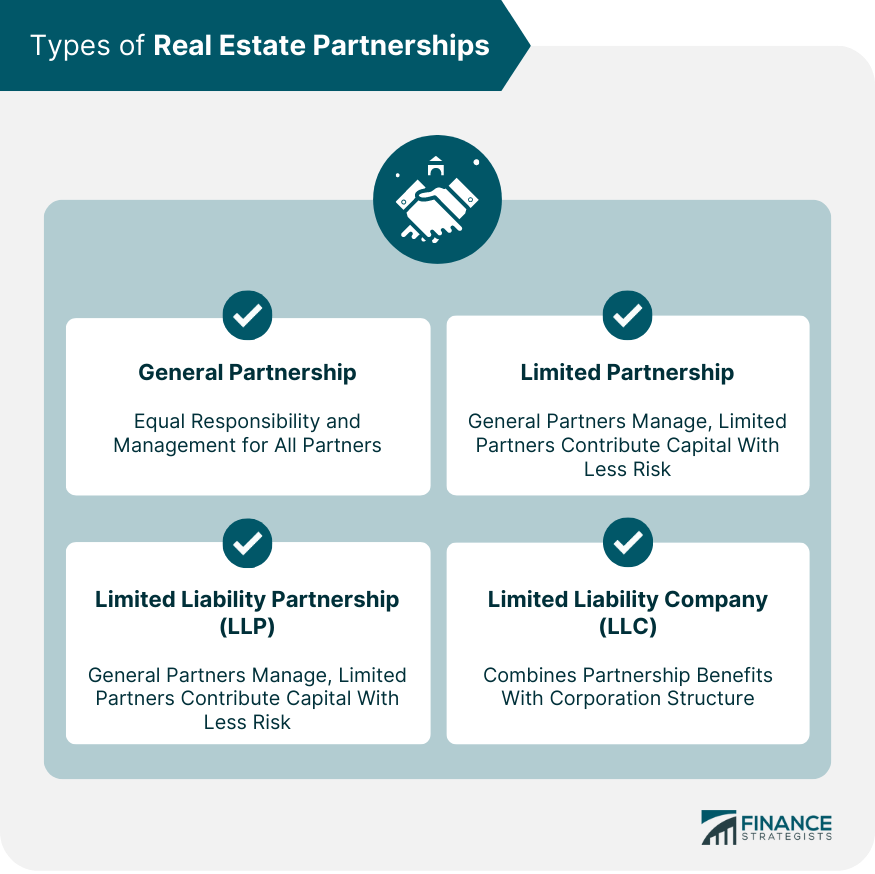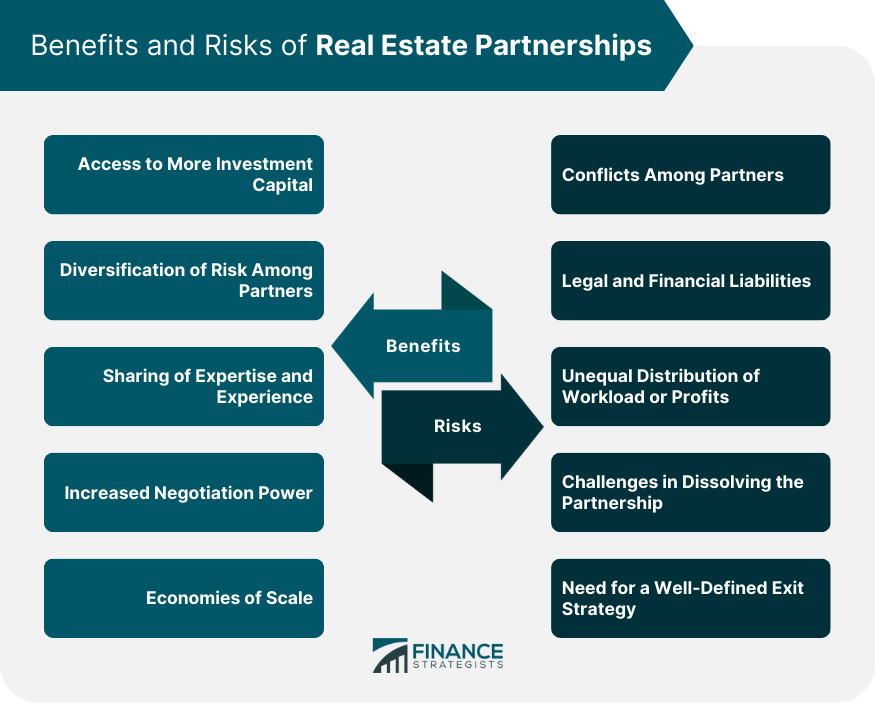Real estate partnerships are formed when two or more individuals or entities come together to jointly invest in and manage a real estate project or portfolio. These partnerships allow investors to pool resources and share both the financial risks and rewards of a real estate investment. Partnerships can take various forms, such as general partnerships, limited partnerships, or limited liability companies, each with its own legal and financial implications. In a general partnership, all partners share equal responsibility for the management of the partnership, its liabilities, and its profits or losses. Each partner has a fiduciary duty to act in the best interests of the partnership and other partners. A limited partnership consists of general partners, who manage the partnership and are personally liable for its debts, and limited partners, who contribute capital but have limited liability and involvement in management decisions. An LLP provides each partner with limited liability protection, similar to that of a limited partner in a limited partnership. However, in an LLP, all partners can actively participate in the management and operation of the partnership without incurring personal liability for the actions of other partners. An LLC is a hybrid entity that combines the benefits of a partnership with those of a corporation. Owners, or members, of an LLC, enjoy limited liability protection and pass-through taxation, while the company can be managed by its members or by appointed managers. To form a successful real estate partnership, it is crucial to carefully select partners who bring complementary skills, financial resources, and a shared vision to the partnership. Key factors to consider when evaluating potential partners include: Skills and expertise Financial capabilities Compatibility and trust A partnership agreement is a critical document that outlines the terms and conditions of the partnership. It should address key aspects such as: Roles and responsibilities Financial contributions Decision-making processes Profit and loss sharing Exit strategies and dissolution Equity financing involves raising capital for the partnership through personal contributions, private investors, or crowdfunding platforms. Debt financing entails borrowing money to finance the partnership's real estate investments. This can be achieved through bank loans, private loans, or seller financing. Successful real estate partnerships require thorough market research, property inspections, and legal compliance checks before acquiring a property. Effective property management is essential for the success of real estate partnerships. Key aspects of property management include: Tenant acquisition and relations Maintenance and repairs Financial management and recordkeeping Real estate partnerships can grow by diversifying their property portfolios, pursuing value-add opportunities, or engaging in property flipping. Real estate partnerships typically enjoy pass-through taxation, allowing partners to report their share of the partnership's income, deductions, and credits on their personal tax returns. Depreciation and tax deductions can also significantly impact partners' tax liabilities. Real estate partnerships must comply with various legal and regulatory requirements, including zoning and land use regulations, environmental compliance, and fair housing and tenant rights laws. Failure to adhere to these regulations can result in penalties, fines, and legal disputes. Real estate partnerships may dissolve or divest their interests through various exit strategies, such as: Property sale Property refinancing Buyout of a partner's interest Dissolving a real estate partnership involves several steps, including: Meeting legal requirements for dissolution Distributing partnership assets and liabilities among partners Addressing tax implications of dissolution Real estate partnerships can provide access to additional investment capital, diversification of risk among partners, and the opportunity to share expertise and experience. By pooling resources, partners can gain increased negotiation power and economies of scale. However, partnerships also carry potential risks, such as conflicts among partners, legal and financial liabilities, and unequal distribution of workload or profits. Dissolving a partnership can also be challenging, so it is essential to have a well-defined exit strategy in place. Effective communication, clear roles and responsibilities, and a shared vision are crucial to the success of a real estate partnership. In order to optimize the chances of success for a real estate partnership, adhering to best practices is essential. Some of these best practices include: Maintaining open lines of communication and transparency among partners is critical for fostering trust and addressing potential issues before they escalate. Regular meetings, progress reports, and a culture of honesty and openness can help create a strong foundation for the partnership. Establishing clear goals and objectives for the real estate partnership will help ensure that all partners are aligned and working towards a shared vision. This includes both short-term and long-term goals, as well as specific performance metrics and milestones. Disagreements and conflicts are inevitable in any partnership. Having a conflict resolution process in place, such as mediation or arbitration, can help partners resolve disputes amicably and efficiently, minimizing disruptions to the partnership's operations. Staying current on industry trends, market conditions, and new investment opportunities is crucial for the success of a real estate partnership. Encouraging and supporting ongoing education and professional development for all partners can help ensure that the partnership remains competitive and adaptable. Regularly monitoring and evaluating the partnership's performance, as well as the performance of individual partners, can help identify areas for improvement and inform strategic decision-making. This process should include both quantitative and qualitative assessments, as well as feedback from all partners. Real estate partnerships are formed when two or more individuals or entities come together to jointly invest in and manage a real estate project or portfolio. The different types of real estate partnerships include general partnerships, limited partnerships, limited liability partnerships, and limited liability companies, each with its own legal and financial implications. The benefits of these partnerships include access to more investment capital, diversification of risk among partners, and economies of scale, but there are potential risks, such as conflicts among partners and legal and financial liabilities. Effective communication, clear roles and responsibilities, and a shared vision are crucial to the success of a real estate partnership. Identifying potential partners, developing a partnership agreement, and financing real estate partnerships are also key considerations. Strategies for growth, taxation and legal considerations, and best practices for real estate partnerships such as open communication, clearly defined goals and objectives, and performance monitoring and evaluation are also important factors.What Are Real Estate Partnerships?
Types of Real Estate Partnerships

General Partnership
Limited Partnership
Limited Liability Partnership (LLP)
Limited Liability Company (LLC)
Establishing a Real Estate Partnership
Identifying Potential Partners
Developing a Partnership Agreement
Financing Real Estate Partnerships
Equity Financing
Debt Financing
Property Acquisition and Management
Property Selection and Due Diligence
Property Management
Strategies for Growth
Taxation and Legal Considerations
Tax Implications for Real Estate Partnerships
Legal and Regulatory Compliance
Exit Strategies and Dissolution
Types of Exit Strategies
Dissolution Process
Benefits and Risks of Real Estate Partnerships

Best Practices for Real Estate Partnerships
Open Communication and Transparency
Clearly Defined Goals and Objectives
Conflict Resolution and Mediation
Ongoing Education and Professional Development
Performance Monitoring and Evaluation
Conclusion
Real Estate Partnerships FAQs
Real estate partnerships can be structured in various ways, including general partnerships, limited partnerships, limited liability partnerships (LLPs), and limited liability companies (LLCs). Each type has its own benefits and drawbacks, offering varying levels of liability protection and management involvement for the partners.
Real estate partnerships offer numerous benefits to investors, such as access to more capital for investment, diversification of risk among partners, sharing of expertise and experience, and increased negotiation power and economies of scale.
Risks and challenges in real estate partnerships include potential conflicts among partners, legal and financial liabilities, unequal distribution of workload or profits, and difficulties in dissolving the partnership.
When establishing a real estate partnership, it is important to carefully select partners who bring complementary skills, financial resources, and a shared vision to the partnership. Additionally, developing a comprehensive partnership agreement addressing roles and responsibilities, financial contributions, decision-making processes, profit and loss sharing, and exit strategies is essential for a successful partnership.
Real estate partnerships can stay competitive and adaptable by staying informed about industry trends, embracing technology-driven property management, exploring sustainable and energy-efficient building practices, and seeking emerging investment opportunities in new markets and property types. Ongoing education and professional development can also help partners stay up-to-date and prepared for changes in the real estate market.
True Tamplin is a published author, public speaker, CEO of UpDigital, and founder of Finance Strategists.
True is a Certified Educator in Personal Finance (CEPF®), author of The Handy Financial Ratios Guide, a member of the Society for Advancing Business Editing and Writing, contributes to his financial education site, Finance Strategists, and has spoken to various financial communities such as the CFA Institute, as well as university students like his Alma mater, Biola University, where he received a bachelor of science in business and data analytics.
To learn more about True, visit his personal website or view his author profiles on Amazon, Nasdaq and Forbes.











